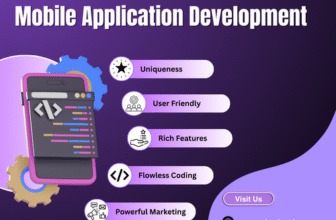The Cost of Developing a Mobile App in 2024: What You Need to Know


As mobile apps continue to drive innovation and business growth, understanding the costs associated with app development is crucial for companies looking to create successful products. The cost of developing a mobile app in 2024 can vary significantly based on several factors, including the complexity of the app, the development team you hire, and the technology stack you choose. This article breaks down the key factors that influence mobile app development costs and provides insights into budgeting for your project.
1. Factors That Affect Mobile App Development Costs
The cost of developing a mobile app in 2024 is determined by a variety of elements, including:
App Complexity
One of the most significant cost drivers is the complexity of the app. Mobile apps fall into three main categories:
- Simple Apps: Apps with basic functionalities like a login page, user profile, and minimal navigation. These apps generally cost less to develop, ranging between $20,000 and $50,000.
- Moderately Complex Apps: Apps with additional features such as payment processing, real-time chat, API integration, or basic admin panels. These apps are more expensive, typically costing between $50,000 and $150,000.
- Highly Complex Apps: Apps with advanced functionalities like AR/VR, AI-driven features, real-time data syncing, or IoT integration. These apps can range from $150,000 to well over $500,000, depending on the scope and technology involved.
Platform: iOS, Android, or Both?
The choice of platform can also affect the cost. Developing for both iOS and Android typically requires more time and resources than developing for a single platform. However, with the rise of cross-platform development tools like Flutter and React Native, businesses can save costs by developing apps that run on both platforms using a single codebase.
- iOS Development: Often slightly less expensive due to fewer device variations and a streamlined ecosystem.
- Android Development: Usually requires more testing due to the wide variety of devices and screen sizes, which can increase costs.
Development Team: In-House, Freelancers, or Agency?
The cost of hiring a development team varies based on your approach:
- Freelancers: Hiring freelancers can be more affordable, with hourly rates ranging from $30 to $100, depending on location and experience. However, managing freelancers and ensuring quality can be challenging.
- In-House Team: Building an in-house development team provides more control but is costly due to salaries, benefits, and overhead costs.
- Development Agencies: Working with a professional development agency offers a full package (design, development, and testing) but can be more expensive. Agencies typically charge $100 to $250 per hour for their services.
2. Additional Costs to Consider
UI/UX Design
Creating an intuitive and visually appealing user interface is critical for app success. UI/UX design costs typically range from $5,000 to $30,000, depending on the complexity of the app. Investing in good design is essential for user engagement and retention.
Backend Development and APIs
Most mobile apps require a backend system to manage data, user accounts, and content. Backend development, including server setup, database management, and API integration, can add $10,000 to $100,000 to the overall cost, depending on the complexity of the infrastructure.
App Security
With the increasing focus on data privacy and cybersecurity, implementing strong security features is essential. Integrating encryption, two-factor authentication, and secure payment gateways can increase development costs but are necessary for protecting user data and ensuring compliance with regulations like GDPR and CCPA.
Testing and Quality Assurance (QA)
Ensuring your app functions flawlessly across various devices, operating systems, and scenarios requires rigorous testing. QA costs can range from 10% to 30% of the total development cost, but cutting corners on testing can lead to poor user experiences and costly fixes post-launch.
3. Ongoing Costs After Development
Once the app is developed, there are ongoing costs to keep in mind:
App Maintenance
Post-launch maintenance is crucial to keep your app running smoothly, fix bugs, and release updates. Ongoing maintenance costs typically account for 15% to 20% of the initial development cost per year. This includes server upkeep, OS updates, and performance monitoring.
App Store Fees
Both Apple and Google charge fees for hosting apps on their platforms. Apple charges a $99 annual fee for the App Store, while Google charges a one-time $25 fee for Google Play.
Marketing and Promotion
Marketing is essential to ensure your app reaches its target audience. App marketing strategies, including social media campaigns, influencer partnerships, and app store optimization (ASO), can significantly impact your budget. Marketing costs vary, but businesses should allocate at least 10% to 30% of their budget to promotion.
4. Cost-Saving Strategies for App Development
While developing a mobile app can be expensive, there are ways to reduce costs without compromising quality:
Cross-Platform Development
Using cross-platform frameworks like Flutter or React Native can significantly cut development costs by allowing you to build apps for iOS and Android simultaneously with a single codebase.
Outsourcing Development
Outsourcing development to regions with lower labor costs, such as Eastern Europe, India, or Southeast Asia, can reduce expenses while still providing high-quality work. However, it’s important to thoroughly vet potential developers to ensure quality and communication standards.
Minimum Viable Product (MVP)
Launching an MVP with core features can help reduce initial costs while allowing you to gather user feedback before investing in more complex features. This approach helps you refine your app based on real user needs and market demand.
Conclusion
The cost of developing a mobile app in 2024 depends on various factors, including app complexity, platform choice, development team, and additional features like security and backend integration. By understanding these factors and implementing cost-saving strategies like cross-platform development and outsourcing, businesses can create high-quality mobile apps within their budget.
While the upfront investment can be significant, the long-term benefits of a well-developed, user-friendly app can drive substantial returns in terms of user engagement, brand loyalty, and revenue growth.







